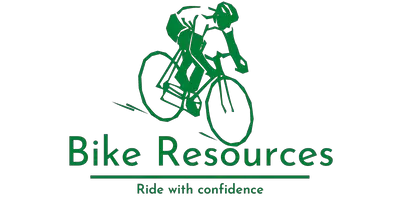How To Wheelie On A Motorcycle _ Step-By-Step Guide!
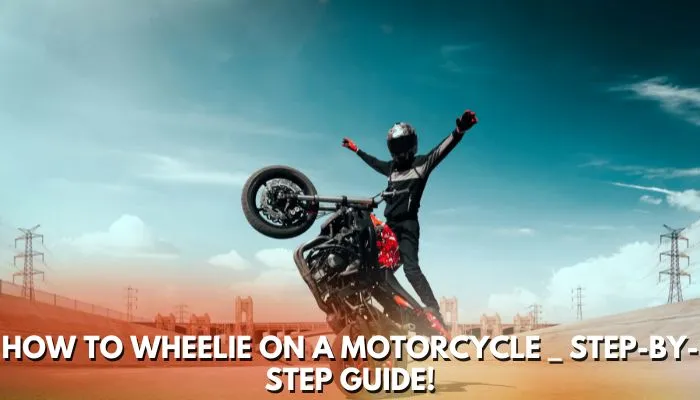
Are you dreaming of wheelie a motorcycle one day? Well, dreams do come true. And it is always fun to learn something new and to master different skills in life.
Table of Contents
Short Answer
Wheeling is also a matter of debate among people, so some appreciate it, and some strictly prohibit it. Learning how to wheelie a motorcycle isn’t harmful, and nor does its application; the only thing that matters is how you do it. Any risky act without proper precaution is a foolish act.
Learn whatever skill you want by always including its pros and cons. In our article, you will learn every basic guideline regarding wheelie on a motorcycle along with the safety gears, types of wheelie, etc.
How to Wheelie On a Motorcycle| Basic Information:
Wheelie on a motorcycle has two types. It’s up to you which one you want to follow. There is brief information regarding how to wheelie on a motorcycle.
Types of Wheelie
Mastering a wheelie on a motorcycle requires a lot of patience, time, and skills, and safely landing on the ground after wheeling will only make your ride better. Following are the types of wheelies which will help you to understand how to wheelie on a motorcycle;
Power Wheelie
The power wheelie has a throttle that provides the maximum speed required for lifting the front wheel from the ground. You can achieve it by slowly rolling off the throttle and snapping it back, which allows the front wheel to rise and, once grown, maintain your balance and keep throttle input.
It is comparatively easier than the clutch wheelie because you have nothing to do with the clutch and perform the power wheelie smoothly.
Clutch Wheelie
The name proposes to bring the front wheel up; the clutch-up combines clutch and throttle. It is a bit more challenging to perform and pull off than the power wheelie, but they are usually much flatter and calmer to ride out. Now that you know and are familiar with the types, it’s time to learn the basics of implementing each.
Step-by-Step Guidance on Power Wheelie
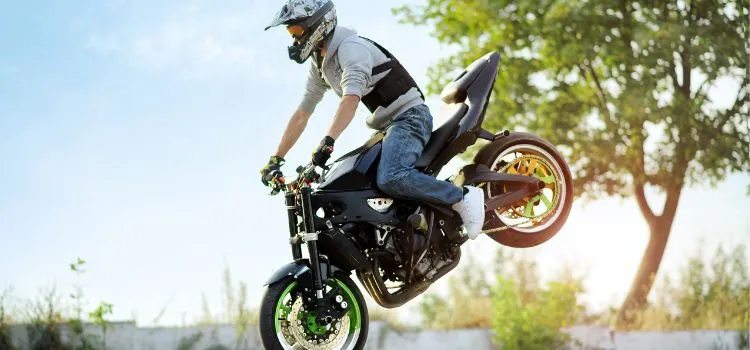
Now following steps will guide you to learn and practice wheelie on the motorcycle;
Step 1: The Correct Gear
Choosing the right gear is essential because power wheelies use absolute acceleration to lift the front wheel of your bike into the air. It depends on the size of your machine or engine motorcycle; the correct gear doesn’t have to be first, but starting slow with the first gear is hugely commendable.
Step 2: Speed Up your Motorcycle
If you want to start at approximately 10-15 miles per hour when learning to perform a wheelie. Too slow and too fast both have consequences; if you are too slow, you will risk looping the bike, and too quickly will make you lose your balance and fail miserably.
Step 3: Work with the Throttle
After achieving the maximum speed, you aimed for, quickly roll off the throttle. Forks will compress and now shift the weight forwards toward the front wheel. Now quickly back open the throttle and lift! The bounce of the forks and absolute acceleration will work together so that lifting the front wheel becomes easier.
Step 4: The Key is to Balance
If you learn balance, the rest of the wheelie process will become very easy for you to exceed. Find and maintain a balance point if you want to ride a wheelie gracefully. Apply more throttle so that you can bring the front wheel up further.
And if you’re going to bring the front wheel down to the ground, roll off the throttle. Some professional says that instead of alternating between the throttle and rear brake, the main aim is to find where the bike appears appropriately balanced when applying the constant throttle.
Step 5: Time to Down the Front Wheel
When you are ready to set down the front wheel, moderately move off the throttle, and if you think to apply the brakes, do it slowly. Ensure that you are at the center of your seat and ensure your front wheel is in a straight position to make it land safely.
Step-by-Step Guidance on Clutch Wheelie
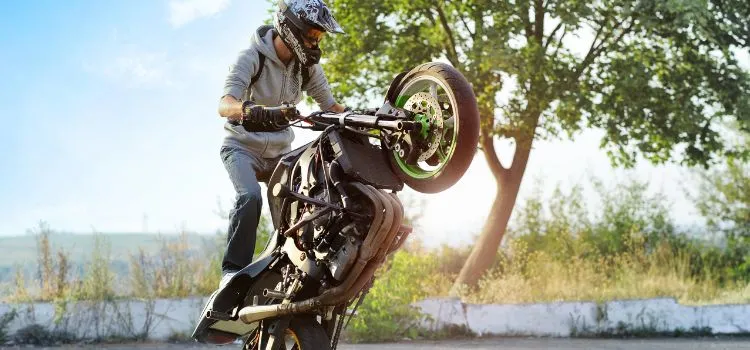
After the power wheelie comes the clutch one; it is a little tricky and needs to be done more efficiently. Following are the steps as follows;
Step 1: The Correct Gear
No matter how powerful your motorcycle is, you want to learn to clutch up in the first gear. First and second gear is usually preferable on smaller engines because, other than that, it is difficult.
Furthermore, there are liter motorcycles in which you can go up to second and beyond gear if you try hard.
Step 2: Speed Up
Same as the power wheelie, and start at approximately 15 miles per hour. When you are confident enough, start popping the clutch and lift the front wheel in the air; after that, you can try to accelerate your speed.
Step 3: Clutch Popping
Riding at 15 miles per hour, start to pull off the throttle; right after that, roll in the clutch again, apply the throttle, and release the grip quickly.
Key point
The application of throttle and, right after that, the release of the clutch is so important and should be done quickly, or else either you will lift the wheel or may slightly roll forward.
So practice is the key to all of the act. The more you practice, the more you can lift the wheel.
Step 4: Balancing
Once the front wheel is lifted, the process is similar to the power wheelie of the motorcycle. More throttle is necessary to bring the wheels up in the air, and lowering the throttle to bring the revolution down. The main aim is to maintain the balance of the motorcycle perfectly.
Key point
It was bouncing off the front end up and down in the air and trying to keep it lifted. It isn’t a suitable position, nor will it bring any charm to your wheelie. Instead, you may lose control and balance of the motorcycle.
Step 5: Lower Down the Front Wheel
Make sure your front wheel is pointing forwards; now, slowly pull off the throttle, and bring the front end down. If applying the rear brake is necessary, use it.
The correct use of the throttle will make the wheelie easier. Instead of suddenly switching off the throttle, do it slowly and smoothly. Suddenly reducing the power of the rear wheel isn’t wise at all.
How to Tackle Wheelie Problems?
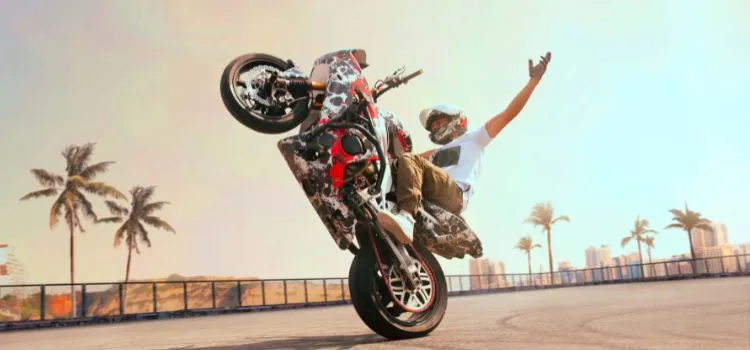
After learning how to wheelie on a motorcycle, the following are the few problems that usually arise during a wheelie; solutions to such issues are as follows;
- Improper Balance
When the rider goes beyond the pointed balance point, things change; in that case, only the rear bike helps. Professionals recommended covering the rear brake because that is the only way to control the motorcycle.
The best way is to remain and maintain the pointed balance, and proper throttle control helps to keep the balance. And in the case of a clutch wheelie, clutch control is essential.
- Initiate The Wheel Properly
You have to initiate the wheel properly to avoid a severe solution. Keep the motorcycle in a straight line, and in the middle of the seat, your weight is placed correctly to ensure you are in the proper balance position.
Key point
The key is to balance both sides and give power equally. Once the wheel is lifted, you can shift your weight on the seat and pegs, and remember this is an advanced technique.
- Running into Obstacles
While wheelieing the motorcycle, the rider’s view is obstructed, and he can’t see the natural picture, which can result in it running directly into the hurdle.
Moreover, the ability to steer and apply brakes isn’t easily applicable, so wheeling isn’t permissible in some countries on main public roads.
Flat and open large roads are suitable without any public or traffic, though the realistic view will permanently block you while lifting the motorcycle wheel; you can look around to get an idea of where you are heading.
- Head Shake
A head shake happens when the front and rear ends go differently. When the rider tries to land in a straight line in which the motorcycle is going resulting in a head shake; so to avoid it, with complete control, try to put off the front end and in which direction you are traveling. A steering damper may minimize the effect of a head shake.
- Damaging the Motorcycle
It is common sense that you can suddenly bring the lifted wheel down to the ground. It will seriously cause damage to your bike. When it goes up will come down for sure but with a proper technique. Or else you will end up in a crash.
FAQs
How Does Wheeling Occur?
The wheelie is a fun, risky, and yet typical motorcycle stunt. The basic principles are the same as the principle of any other bicycle wheelie; the following components help to perform the wheeling:
● The throttle and rear brakes control the wheelie.
● Rider’s body weight and the steering are used to manage the direction of the motorcycle.
● To balance the wheelie, the inertia of the spinning front wheel works in favor of it.
Is Wheeling Useful?
Yes, it is helpful to avoid uneven edges and potholes and helps navigate the perfect road surface.
Is Wheelie Control Installed in Motorcycles?
Yes, it is known as ad anti-wheelie system in motorcycles; it works on a rudimentary system that controls the power. It monitors both the rear and front wheels with the help of ABS rings and whenever the wheel tries to lift or the speed doesn’t match the wheel, it cuts the fuel supply to the engine.
Conclusion
It is no doubt that a wheelie on a motorcycle is thrilling, and yet it gives more confidence and a sense of freedom when you learn it and perform it perfectly. People get inspired by such professionals, but because people, especially youngsters, look to you, you must be extra careful while performing any motorcycle stunt. Safety gear and kids who look up to you are essential.
Some riders perform wheelie and other motorcycle stunts very carelessly, resulting banning of stunts or a prohibition period for the rider as well extended. How to wheelie on a motorcycle is adventurous, so give a positive image by performing it with safety
